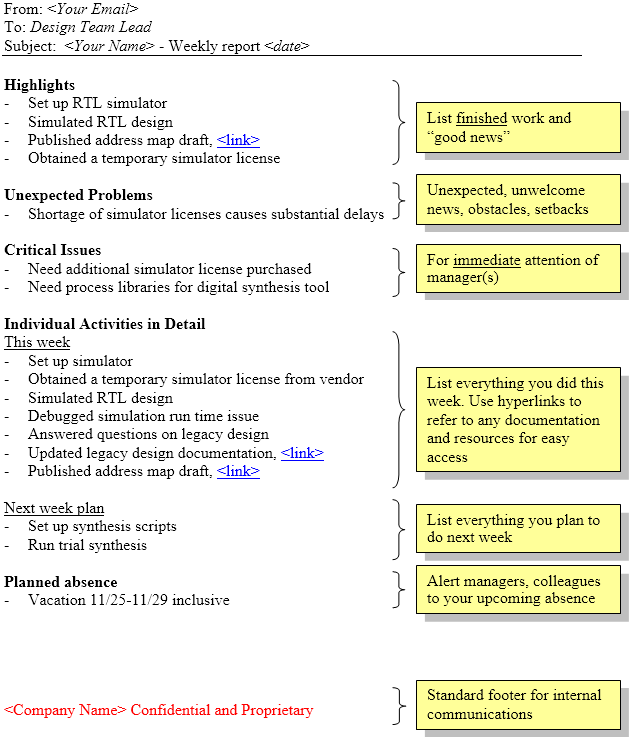This posting begins a series of commentaries dedicated to weekly reports. Weekly reporting is a common kind of organizational activity, which managers might be taking for granted. Let’s ask ourselves and ponder for a moment – exactly what purpose weekly reports serve? How can we perfect our weekly reports?
Perhaps the first thought that comes to mind to answer the first question is – weekly reports are used to monitor progress. Are there any other reasons? I believe there are eleven more important purposes served by weekly reports.
Weekly reports is an important management tool. The larger the team or organization, the more important it is to practice excellent reporting. I will address this topic in considerable detail and provide a number of ready-to-use templates for download. Specifically I would like to provide and discuss
- A sample of individual contributor’s report
- A sample of team lead/manager’s report
- 12 purposes a weekly report serves
- Variations on the “basic” report
- Advice on troubleshooting common problems associated with weekly reports
I hope that after reading these commentaries you will critically consider your own weekly reports in a new light – and perhaps take a step to redesign them for better efficacy.
Let us start by reviewing an example of what I consider the “basic” weekly report for an individual contributor. You can download PDF of the sample report here.
Instructions
- Start by filling out “This week” section. List all activities you have performed
- Copy items reporting finished work from “This week” section to “Highlights”
In this section, make sure to state accomplishments, not status of activities. Do not write about work-in-progress. Definition of accomplishment varies – it could be a report having been published, module design finished, test passed, release made, etc. You may also include “good news”, which designate welcome developments. For example product performing better than expected, significant customer order received and so on.
- If applicable, write unexpected, unwelcome news in the “Unexpected Problems” section
- If applicable, fill out the “Critical Issues” section.
Any message(s) placed in this section are meant to receive immediate and full attention from your manager.
- Fill out “Next week plan” section
Be specific and list everything you think you will be doing. If someone requested you to do certain work next week and you agreed, reflect that request in this section to confirm that you have accepted the request and will be taking care of it.
- If applicable, fill out the “Planned absence” section
Alert your managers and colleagues to your planned absence as early as possible
- Be diplomatic, professional and courteous in your writings. Weekly reports should not be used as blame press.
Keep your reports clear and complete. To help your colleagues access resources easily, embed hyperlinks to all relevant documentation, publications or reports.
Submit your report on time. If you are out of office, consider submitting your report before departing.
- Address your report to the team lead/manager.
It is acceptable to copy other team members, however consider that your colleagues may not want to be flooded with redundant emails if your report will be incorporated into the team lead’s weekly.
As you can see, the individual contributor’s report exemplified above aims to communicate weekly status in a clear fashion. Items of high importance – highlights, unexpected problems and critical issues – are set apart and placed at the top for immediate manager’s attention. You may notice that the top of the report now looks like an executive summary. Yet, such filtering for purposes of clarity does not come at the expense of completeness. The “Individual Activities” section provides a comprehensive account of everything that happened throughout the reporting period.
At the end of this posting I’d like to give an example of reporting activities clearly. Consider these two items
- 55 test passed
- 55 tests out of 230 passed (+5 this week)
The first formulation reports status, not progress. Progress is the amount of work between now and one week ago. To understand the progress the reader must retrieve the last week’s report, which could says something like “50 tests passed”, and compare the status then to the status now.
The second formulation reports status (55), progress (+5) and also puts these number into perspective (230 total). Do you think reader will appreciate this particular wording? Perhaps so.

